By Jeffrey Ressner
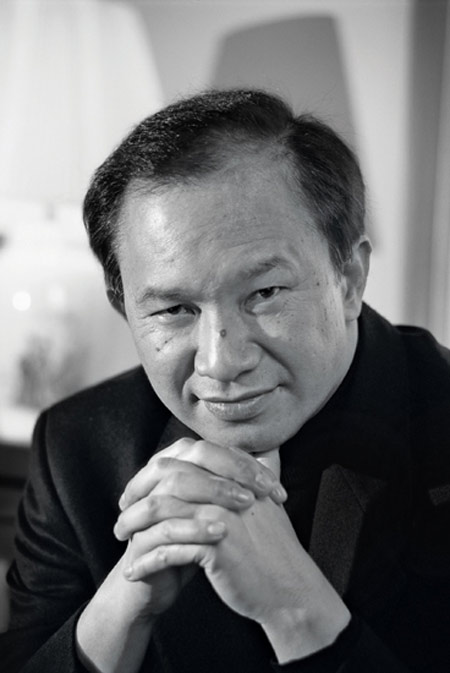 Sergio Leone, Sam Peckinpah and Quentin Tarantino, among others, have each contributed their own stylish approach to guns-a-blazin’ shootouts. But few—if any—have managed to top the decibel level, body count and visual poetry of John Woo. His late-’80s Hong Kong masterpieces, including The Killer (1989) and A Better Tomorrow (1986), redefined action films. Yet the director topped even himself with his final and influential Hong Kong feature, Hard Boiled, about a loner cop facing off against vicious gun smugglers.
Sergio Leone, Sam Peckinpah and Quentin Tarantino, among others, have each contributed their own stylish approach to guns-a-blazin’ shootouts. But few—if any—have managed to top the decibel level, body count and visual poetry of John Woo. His late-’80s Hong Kong masterpieces, including The Killer (1989) and A Better Tomorrow (1986), redefined action films. Yet the director topped even himself with his final and influential Hong Kong feature, Hard Boiled, about a loner cop facing off against vicious gun smugglers.
Police inspector “Tequila” Yuen (Chow Yun-Fat) fires away in the film’s early shoot-em-up at a Hong Kong teahouse, and, later, during the film’s explosive half-hour climax at a hospital. When filming began there was a different script, no firm characters, not even a credible storyline. The director had heard that an historic Hong Kong teahouse was slated for demolition and he wanted to capture the old building on film for posterity. Woo and his crew were granted carte blanche to blow the famous place to bits—and did exactly that.
The director, who had hoped to shoot the six-minute opening gunfight like “a war movie,” also drew from his experience as a ballroom dance instructor. Woo choreographed the scene with slow-motion turns, jumps, slides, and rotations, leading critics to laud his “ballets full of bullets.” Thanks to Woo’s over-the-top imagination, as well as the skills of veteran Hong Kong stunt coordinator Philip Kwok and longtime cinematographer Horace Wong Wing-hang, he created a shattering sequence that set a whole new standard for the genre.
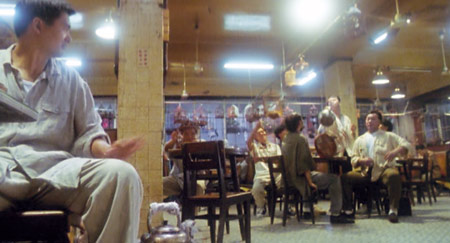
This establishing shot points out the relationship between the hero, Tequila (Chow Yun-Fat), sitting up front on the left, and the gangsters in the background. I shot from a low angle to capture the entire teahouse and used a wide-angle lens, probably an 18 mm, with a light Arriflex handheld camera. We had about two or three cameras during the teahouse shoot and, while I don’t usually like handheld cameras because they shake too much, we occasionally used them for shots such as this. There’s a lot of action in the teahouse sequence, but I never used a storyboard for my Hong Kong movies and didn’t rehearse much, either. I’d just do walkthroughs with the actors and crew to block things out.
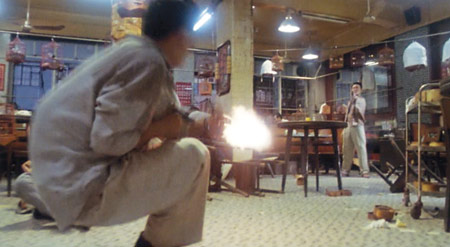
This is the start of the entire gunfight. Here’s Chow Yun-Fat kneeling and firing the guns he found after smashing in the bottom of a birdcage, where the smugglers had hidden them. We had five days to shoot the tearoom scene, because they were going to tear down the place at the end of the week. I know a lot of other directors don’t usually work this way, but I always like to shoot my films—even specific scenes—in sequence, so that the opening helps to set up the mood and the tempo for the entire picture. I’ll usually film the first scene first, starting things right from the beginning. That way, after I finish the first action scene, the next one is even better than what came before.
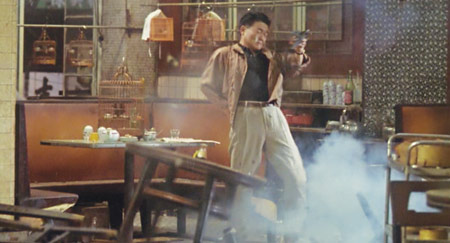
Here the gunman gets shot in the legs, and there’s a lot of smoke in the corner of the frame. In action scenes I usually like lots of things happening at once—big plumes of smoke or fires burning, or something else. If there’s no smoke, sometimes I’ll use fireworks that shoot off lots of sparklers. I like to blow up everything and anything so, before we shot the gunfight scene, I walked around the whole restaurant looking for things to explode. If I saw stacks of papers on a desk we’d use that. Or maybe the tickets waiters used for their food orders. If we were close to the kitchen, I might ask, ‘How about blowing up a gas tank?’
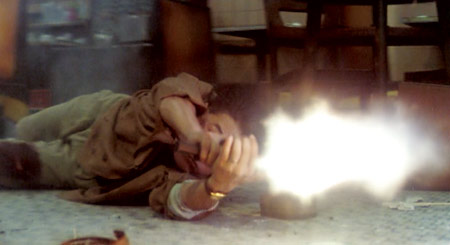
When we shot near the ground, like this, we didn’t use a tripod; we just put the camera on top of a little box to get an extremely low angle. Cameraman Wong Wing-hang was very close to the gunfire. A lot of crazy things happened while shooting this movie, and we had a very brave camera crew. If I saw that a fire from an explosion was still burning, I’d push Wong to grab the camera and go inside the fire. He and his assistant would unscrew the camera from the tripod in five seconds. With one hand he’d hold the camera, and with the other he’d throw a wet towel over his head and run right into the flames. Those guys had a lot of guts.
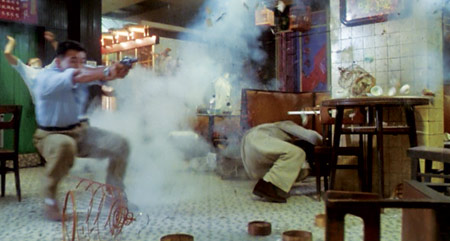
By this point, smoke was filling up the entire teahouse. Lau Hon-Cheung, a good friend of mine, is the best special effects coordinator in Hong Kong. He’d use anything he could find to produce more smoke—gunpowder, fireworks, sometimes incense or just plain sheets of paper. We never used dry ice, but occasionally we’d use a smoke machine, though not often because the chemicals were really hard on the crew. Mostly we just burned a lot of paper and gunpowder. In all of my Hong Kong films, no one ever got hurt, even though we were constantly experimenting and trying out new things. Occasionally an actor would get a very small bruise from an exploding squib attached to his body, but never anything much worse than that.
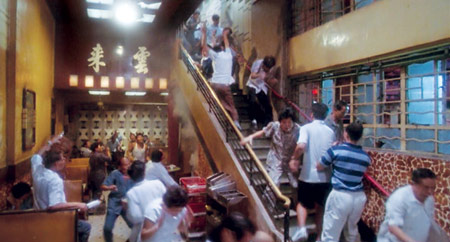
For every action sequence, we’d always look for one really special setup. Now remember, before we went to this location we didn’t really have a story or script or even know how the action would work. When we walked into the building and saw these stairs, suddenly an idea came to me and so I asked the stunt coordinator, ‘Wouldn’t it look great to have our hero slide down this banister shooting with two guns?’ We devised it so it appeared that lots of panicked, innocent people would get shot and killed, just like the real events happening in the news. And we decided our hero would be a tough guy, like Clint Eastwood in Dirty Harry, someone who’d never give up.
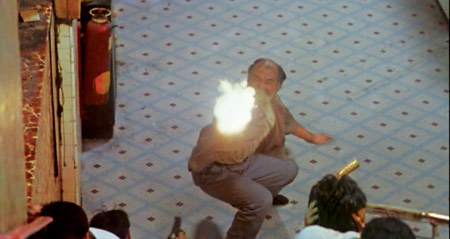
This is a simple moving shot from Chow Yun-Fat’s perspective as he slides down the staircase towards the gunman. We used a very light handheld camera, and the cameraman wore a harness with someone literally holding him from behind as he was sliding down the stairs. Most of the time, however, I use dolly tracks for every shot, even though we may not be moving the camera. When we do a tight shot of an actor, for example, they might have a little movement or their position may not be completely right, so then we can do a quick adjustment with the dolly to move with the actors and get the perfect angle; whether it’s a close-up or an action sequence.
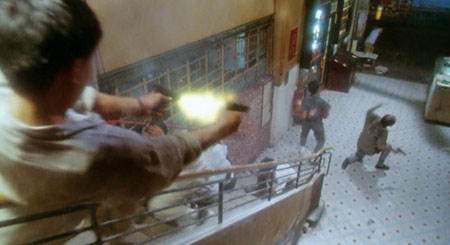
All we needed here were just a few seconds to show how Chow Yun-Fat is sliding down the tall banister from above. So we built a very high platform next to the staircase for the cameraman to stand on, and he would hold up this crane with the camera dangling at the very end of it, almost as if it was hanging off the end of a fishing pole. We only shot at night, from around 5:00 in the afternoon until the next morning—about 12 hours or so. The stairway was near the street, so we got even more protests than usual from neighbors during these scenes. They’d call the police and firemen, but, fortunately, the cops were big fans of my movies and never did anything to stop us.
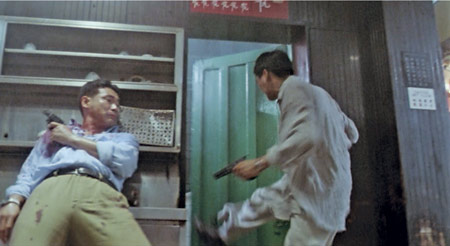
Here we are, back upstairs at the teahouse, using an 18 mm lens and a low angle again. I like using low angles, especially in very narrow and small places. You get the body movement, the background and the entire location in the frame. There’s so much going on here. Chow Yun-Fat is about to kick down the door, he’s dealing with his wounded partner, there’s the suspense of the moment, the question of what’s going to happen next. Fortunately, when I’m shooting these action sequences, I never run out of ideas. I’m crazy, I don’t care about logic. Logic can be very boring. When I’m shooting, I do what I feel.
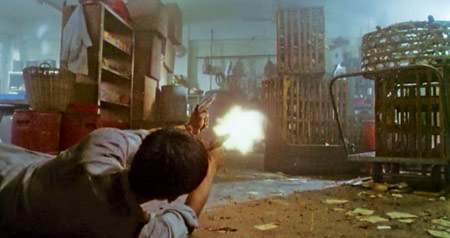
I like to choreograph action pretty much like dancing. When you dance, you feel the beauty of the body’s movement—the slide, slow-motion, flips, or whatever. For this shot, the bad guy behind the door was holding his gun at waist level, so Tequila knew he had to slide into the room very low in order to escape being hit. Some Hong Kong directors didn’t know how to shoot action sequences, so they left everything up to the stunt coordinators. But a great movie has only one style, and that’s why I like to design the choreography and action mostly by myself. When it comes to dance films, West Side Story and [anything by] Bob Fosse are my favorites—I admire them very much.
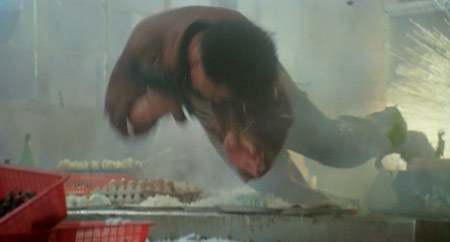
The bad guy is leaping over a baking table in the kitchen, and again this is a low shot taken with a wide-angle lens. It’s a little dark, but so was the room and I like to use natural lighting. We were so concerned about the light sources, and light coming in through the windows. The slow-motion mixed with real time here is important and, of course, I learned so much about that from Peckinpah. The Wild Bunch, Bring Me the Head of Alfredo Garcia, and The Getaway are three of my favorite films. I like the way he used slow-motion to show the beauty of death. His work is always in my mind when I’m making my movies.
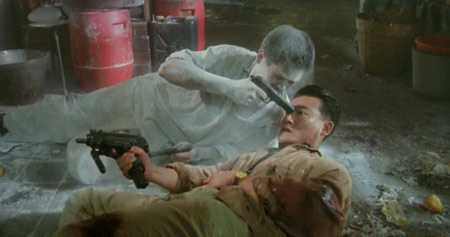
We’ve already established the white flour in the kitchen so, as we see Chow Yun-Fat also roll over the tabletop with the flour covering his body, there’s a direct cut to him holding the gun right up against the bad guy’s head. I edit in my head, so I’ll let the cameraman know how long each shot should be, and sometimes even how many frames I’ll need. Although early on we filmed without any script or even a story, I knew exactly what shots I needed. As difficult as this entire sequence looks, all of the shots were done in one or two takes. I never liked to do more than three takes, and I often use the first one. It’s always the most natural.
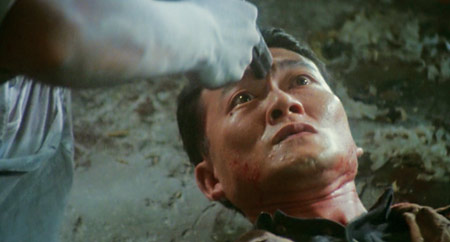
Chow Yun-Fat is just about to kill the bad guy here; his finger is on the trigger that’s right up against his head. It’s a powerful moment—it really really means something. Once a police officer kills a bad guy, it becomes personal. I wanted to show audiences that this character is not perfect. He does things that other cops might want to do, but never would. Before shooting the movie, I was doing research and met a real cop very much like Tequila—handsome, young, and tough. He always gave the bad guys a hard time, and he was known for his aggressive nature and his use of force—what makes a cop ‘hard-boiled.’
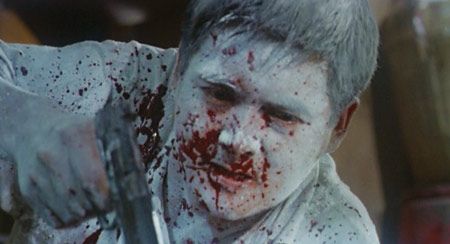
The last shot of the scene is a close-up, with Tequila shooting the bad guy in the head and the blood spraying back onto his face. As we were walking through the sequence, Chow Yun-Fat came up with that—he always has good ideas. He said, ‘How about putting this flour on my face so it’s all white, just like a mask from the Chinese opera. When the blood splatters back, it will make it feel more tragic.’ I loved it because all I need are strong visuals; something that delivers a powerful feeling. The close-up works because it helps to introduce Chow Yun-Fat’s character—he’s tough, he never lets go. There’s no fear.